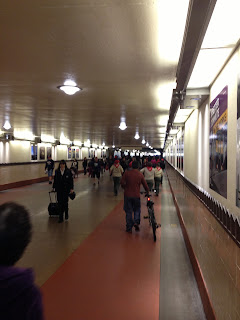A train system is basically made up of many electronic systems, physical assets and workers spread across a geography. This could be a city, region, state or an entire country. In order to provide a safe, convenient and satisfying experience for passengers, these systems need to be integrated and coordinated to provide a unified environment.
Examples of these disparate sub-systems are:
Examples of these disparate sub-systems are:
· Automated Ticket Sales
· Video Displays
· Schedule Information Tote Boards
· Closed Circuit Television
· Public Address Systems
· Building heating and cooling systems
· Electric Drive Power Systems for Subways
· Water and Utilities
· Ventilation
· Security
· Fire Safety
· Drainage Systems
· Weather Monitoring
This problem area uniquely positions this as a space where a Supervisory Control and Data Acquisition Systems or SCADA Systems are a perfect fit. This is because these sub-systems are not all provided by a single vendor, so they inherently do not integrate to share information. SCADA systems have tools to create interfaces to all these sub-systems. Furthermore, SCADA Systems can integrate and control these sub-systems across all kinds of communications networks, from high speed to very low speed networks. The result is the development of new capabilities that that are more than the sum of their parts.
Let’s illustrate this concept by following a typical train passenger, named Jim, who is taking a trip across a town. He starts by purchasing a ticket at the automated kiosk at the train station. The SCADA System counts him along with the other passengers to use the information to optimize service from station to station.As he enters the walkway to the train tracks, where his presence is detected via motion sensors. The SCADA System automatically adjusts the building heating controls to optimize his comfort. Closed circuit TV cameras, controlled by the SCADA system, allow central operations to monitor activities in the walkway, keeping him and other passengers safe from crime.

Jim boards his train that heads down town. The route will take him through the tunnel under the river to reach his destination. There is an approaching storm and a strong wind is blowing out of the north-east and directly down the tunnel entrance. This is causing CO2 levels to raise in the tunnel due to the diesel exhaust fumes from the trains. The SCADA system detects this and switches on ventilation fans to clear the air before Jim’s train reaches the tunnel, protecting his health.
While reroute, Jim checks that status of his train via a smart phone app. This information is passed to the “cloud” via an open interface provided by the SCADA System. Jim also can check the status and times of other stations and trains available on his route. Jim feels more empowered and confident about his trip.
At the next station, the rain is pouring down, overwhelming the drainage system and starting to flood the tracks. The SCADA system detects the water rise and executes special procedures. First it alerts central operations to start routing trains to other stations; second it sends a message to the PA system in the station directing people to exit via the stairs. The text for the message originates in the SCADA System and is converted to an audible message by a text-to-speech program. Lastly it notifies the maintenance department to dispatch a worker to the station to perform any needed repairs. Jim is completely unaware of the situation and his trip is unaffected.
Later that night, after Jim and other passengers have reached home, the traffic in the station slows. The SCADA System detects this and initiates an energy saving program where the building heating temperature is reduced and lights are dimmed in certain areas. This saves the transit authority on operating costs, allowing them to keep ticket prices low so passengers like Jim can continue to ride more trains, more often.
One country that is doing a great deal of investment into rail systems is China. Invensys recently created a customer success story on one such customer; The China Ministry of Rail. You can check it out on this link. And next time… take the train :)






No comments:
Post a Comment